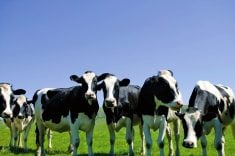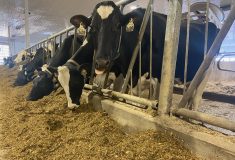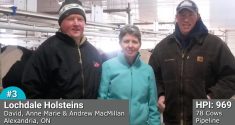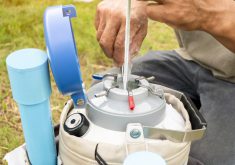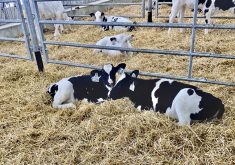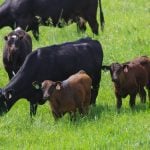A recent webinar by Lactanet’s expert in forage production and nutrition offered tips on how to interpret analyses of ensiled forage.
Jean-Philippe Laroche asked participants to have on hand copies of analyses for grass or legume silage so he could relate “what your forage analyses have to tell you and provide solutions” to address shortfalls or problems.
WHY IT MATTERS: Accurate interpretation of forage analyses can allow producers to identify early problems and protect feed quality.
Read Also
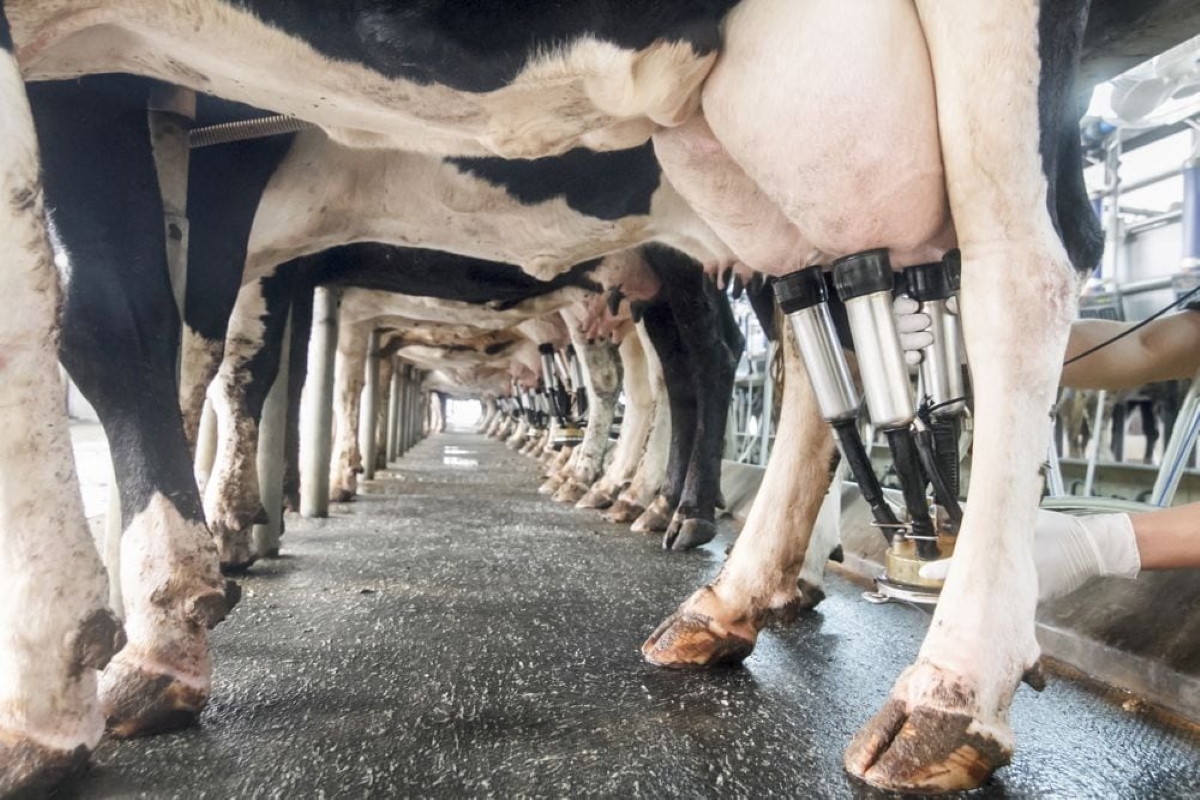
Farm gate milk price to rise in 2026
The Canadian Dairy Commission will raise its farm gate milk price by 2.3255 per cent in February, the Crown corporation announced on Friday.
The three main categories of information are harvest quality, storage quality and mineral deficiencies in the crop.
Acid detergent fibre
Laroche said he first looks for ADF, or acid detergent fibre. It’s an indicator of harvest maturity and should be at approximately 30 per cent of dry matter for silage fed to high-producing dairy cattle. At that level, it should provide the highest possible quantities of desirable sugars and fats.
“When you harvest your forage at the right maturity, everything will follow.”
He said producers worry about harvesting too early because they want to ensure there’s enough fibre in the feed to enhance rumen health and produce fat.
“That’s true, but what we need to remember is that when we have forage that has the right maturity, that has less fibre, we need to increase the amount of that forage in the ration.”
That allows producers to provide the right amount of fibre while potentially reducing other ingredients in the ration to lower feed costs.
Laroche showed a sample calculation comparing a forage at a “moderate” ADF level of 33 per cent of dry matter and an “optimum” forage at 30 per cent. The feed cost was $27.73 per hectolitre of milk versus $23.39 per hectolitre, respectively. Lower feed costs for the forage with 30 per cent ADF are attributed mainly to a reduced need for concentrates, including ground corn, soybean meal, minerals and vitamins.
On a weight basis, it wasn’t a huge shift for the cattle, with 0.8 kilograms of concentrates per day replaced by 0.8 kg of forages, but the cost savings were noticeable.
“This is just for a three per cent difference in ADF, so it has a very important role in feed costs,” said Laroche.
Over the entire season, he advises producers to “take advantage of the physiology of the plant” by adopting the “fast and slow” technique. In spring, alfalfa and other forage plants typically provide a high yield but quality decreases quickly. Laroche advises quick harvest and ensiling to take advantage of this.
If it’s mostly legumes in the crop, harvest at the early bud stage and get it off the field as quickly as possible. If it’s mostly grasses, harvest at the late boot stage.
At the end of the season, crops typically provide a lower yield but the quality decline slows. Laroche advises producers to take longer to harvest and the early plant stage is not as crucial. For legumes, early flower is fine. Grasses can be cut in the early heading stage.
Extended later-season harvest times can also allow for plant recovery going into winter.
For cuttings between the start and end of the season, Laroche said harvest strategy can be dictated by goal. Is it to supply more high-quality forage or is it to build reserves in the crop for subsequent harvests or subsequent years?
Producers might also vary their harvest strategy depending on whether they want to meet the needs of high-producing cows or other members of the herd, such as dry cows and heifers.
Dry matter
The second parameter Laroche checks in a forage analysis is dry matter (DM) percentage. Forage at less than 30 per cent dry matter is a recipe for poor storage, he said. If it’s over 30 per cent, producers may need to adapt storage depending on type of silo or plastic cover.
In Quebec samples, he says about seven per cent are too wet.
“We can’t always control that because it depends on the weather,” but it means the silage loses nutrients through effluent. Bacteria can also lower feed quality.
If the forage is too dry, more oxygen will be present due to insufficient compaction. This promotes moulds and potentially mycotoxins.
For top-unloading tower silos, dry matter should be 30 per cent for smaller diameters or up to 55 per cent for larger ones. The recommendations for bottom-unloading tower silos range from 40-60 per cent dry matter.
Silage packed into bunker silos should be 30-40 per cent dry matter; ag bags should be 35-40 per cent; and wrapped bales should be 45-55 per cent.
Large wrapped bales below 39 per cent dry matter “are a really bad idea,” said Laroche. In some cases the feed may continuously degrade because high moisture keeps the target level for pH stability so low that it’s never achieved inside the plastic.
Ash content
The third parameter is ash content, typically due to contamination of the silage by soil.
“It can really have an impact on your cows’ productivity,” said Laroche.
A normal silage sample has eight to nine per cent ash, and “there’s no energy in ash.”
In his experience with Quebec samples, 18 per cent have too much ash “so there’s definitely room to improve.”
Proper cutting height is the best way to reduce ash, with four inches (10 cm) as his recommended ideal. This has other positive impacts in terms of crop persistence, soil moisture retention and drying time because the swath sits up on the stubble and allows air to pass underneath.
Additional strategies for reducing ash content are a wider swath (there’s less downward pressure per square inch, meaning less crop is pushed down into the soil) and using a rotary mower with flat blades.
Also be mindful of the rake, Laroche said. Some types can turn up soil. Harvest speed may also have an effect.
Storage
When it comes to storage, the ratio of lactic acid to total acids (including acetic and butyric acid) is the most informative element of forage analysis.
Lactic acids, which decrease pH, should make up at least 65 per cent of total acids to achieve optimal fermentation, Laroche said.
Some acetic acid is OK, with up to four per cent expected especially if using inoculants that contain some acetic acid. Ideally, there is no butyric acid but practically, it should not be above 0.3 per cent.
Excess butyric acid was found in 17 per cent of Quebec samples, said Laroche. In wet silages of less than 30 per cent dry matter, “it’s pretty impossible to not have butyric acid.”
Butyric acid can lead to ketosis. If analysis indicates elevated levels, producers must make sure lactating cows don’t receive more than 50 grams per day. For transition cows, the limit is lower — at 20 grams per day — due to their elevated risk of becoming ketotic.
Silage with elevated butyric acid can be diluted with better-quality silage, aired out for 12 hours to allow loss to the air, or simply discarded.

Laroche said producers don’t necessarily see acid ratios in forage analysis “but I think it’s important to ask for them because it can really help you improve the fermentation of your silage.”
Other factors that influence fermentation include ash content and the speed of pH decline.
Manure can also contaminate silage. Harvest at least 28 days after the most recent manure application, he said.
Laroche also advised monitoring pH.
“In order to have good fermentation, we need a rapid pH drop to control the bad bacteria.”
The wetter the forage, the lower the pH must go to achieve stability. If it’s not stable after 21 days of fermentation, consider discarding it.
If silage repeatedly remains pH-active for too long, Laroche advised a review of strategies for harvest maturity and avoiding rain on the forage. Consider cutting in the afternoon to maximize sugar content in the plant and use a wider swath. He suggests 80 per cent of the cutter bar width to encourage airflow underneath.
Conditioning is still recommended for the long drying process with dry hay but not for silage. Stems need to be intact and not crushed to encourage quick drying.
A quick closing of the silo with a good seal ensures optimal fermentation. Laroche said to remember that, even though it has been cut from the root and stem, the plant is still alive after harvest and still consuming sugars while in an aerobic environment.
Research confirms that inoculants can be effective, he added. He encourages producers to consider using one with grass and legume silage, but they shouldn’t be necessary with corn or sorghum silage because these plants should ferment well naturally.
Heating within silo
Forage analysis can also provide insight into heating within the silo. Laroche said to look for a report on ADF as a percentage of crude protein (CP). The magic number is 10 per cent. If more than 10 per cent of protein is CP-ADF, there is a heating problem, and that protein is being made unavailable to cattle.
“You’re basically throwing (that portion of the protein) away.”
Ammonia (NH3) concentration is another important parameter. Again, it’s not always on the analysis but if it is, look at it on a crude protein basis. If NH3 is provided on a dry matter basis, Laroche said to divide this by the amount of crude protein to find out how much is ammonia.
The magic number is 15 per cent. If it’s more than that, it’s an indication of poor fermentation leading to degradation of protein in the silo or plastic, potentially by clostridia.
There is protein in ammonia, Laroche noted.
“The cow can still work with ammonia but you’ll have to buy more bypass protein. And we all know that this bypass protein will cost a lot.”
Dairy producers can watch Laroche’s webinar presentation on Lactanet’s Youtube channel.




